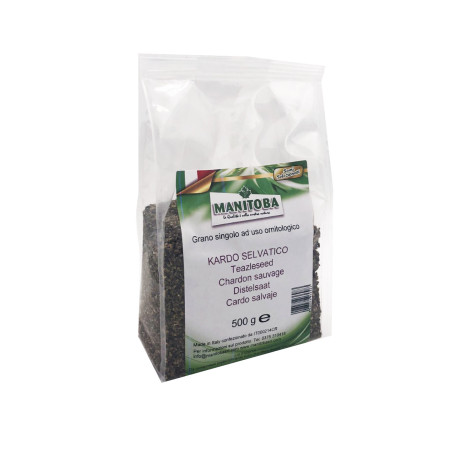- In the process of being restocked






Reference: 3698/S
Common names:
Cardère sauvage, Cabaret des oiseaux, Lavoir-de-Venus, Peigne-à-Loup [Fr], Grote kaardebol [Nl], Wilde Karde [De], Cardo dei lanaioli, Scardaccione selvatico [ Il], Cardencha, Cardo de cardador [Es].
Dipsacus fullonum Linnaeus, 1753
Common names:
Cardère sauvage, Cabaret des oiseaux, Lavoir-de-Venus, Peigne-à-Loup [Fr], Grote kaardebol [Nl], Wilde Karde [De], Cardo dei lanaioli, Scardaccione selvatico [ Il], Cardencha, Cardo de cardador [Es].
Etymology:
Dipsacus comes from the Greek διψαώ [dipsao], to be thirsty. The Romans called the plant "Lavacrum veneris", meaning the basin of Venus, because these leaves of the stem are joined at the base, forming rainwater harvesting cups surrounding the stem.
Carders get their name from the fact that spiny flower heads were used to comb wool fabrics, to "tease" the fibers before spinning them (from Old English teasan, which means to tease). The heads of Fuller's cardera (D. sativus) have curved spines; They were also used to lift the pile, or "nap" of fabric.
Length of flower head: 5 to 8 cm. Stem length: 50 – 150 cm.
Wild thistle is a tall, rather sculptural plant, with a deeply inclined and furrowed stem. The leaves at the base of this stem form a rosette, while those on the stem are arranged in pairs. The tube-shaped flowers are purplish-pink in color and are protected by spines.
Biology:
Wild thistle is a biennial plant that grows from a strong yellow taproot. The flowers are present from July to August and are pollinated by various bees and long-tongued flies. It is known to catch invertebrates in its water-filled leaf bases, but experimental tests of the reproductive benefits of this have been lacking. One study showed that adding dead Diptera larvae to the base of the leaves caused a 30% increase in seed formation and seed mass. This study provides the first empirical evidence of carnivorous reproductive benefit in Dipsacus fullonum.
Habitat: rugged meadows, hedgerows, thickets, roadsides and vacant lots.
Complementary food for professional ornithology.
The multi-complex formula acts on several important metabolic factors in the pre- and post-reproductive phases.
It prepares birds in the best possible way for the hormonal change of spring, supports the immune system, contains female phytoestrogens, promotes a correct and constant flow of testosterone in the blood, keeps the elements necessary for the body stable for greater egg production and more. bioavailability (27% more in experiments with laying hens).
This product contains all-natural and highly selected fibers.
Perfect hygiene and careful treatment make these fibers flexible and dust-free.
This product is designed for nests of all bird species.
Against rats and mice.
Ready-to-use paste bait and strong active ingredient: Brodifacoum 0.0025%. The best value for money when it comes to poison for rats and mice! Suitable for control of mice, brown rats and black rats. 1 ingestion is deadly!
Large 3.5 kg package.
This product is indicated for species that consume a large quantity of fruits and seeds of oilseed plants (genera Psittacus, Ara, Poicephalus) in the wild.
Formula for the reproductive inactivity phase. Its composition allows you to comfortably cover your nutritional needs during these periods.
This food has a formula that covers 100% of the parrot's dietary needs. Other foods such as fruits and vegetables can be added to the diet to provide variety to the diet, as long as the proportion of high energy is not less than 70% of the total.
Pearl Morbide red berries replaces or supplements the administration of the fruit as well as the administering of germinated seeds.
They have a larger diameter than normal morbid pearls and are used for parrots, frugivorous and Insectivores of medium and large sizes.
Complete food for lorises and loriculus
Balanced complete food, in analogy with flower nectar and flower pollen.
High nutritional value and very good assimilation.
Forms a stable solution, in which the powder does not settle.
Recommended by veterinarians and used worldwide by bird parks and champion breeders.
Specific feed for goldfinch farming (goldfinches, Yarrell's goldfinches, yellow-bellied goldfinches, esc). Or any type of finches in general. The wide variety of seeds and organoleptic characteristics of this mixture are perfectly suitable for their diet given their metabolism and microclimatic conditions.
Seed mix designed especially for canaries, especially for the White Rump Serin and the Reddish Araguira.
LONA M5 is a bird feeding silo For small garden birds like chickadees, finches, sparrows and similar species. Easy to attach to a stake, tree trunk, fence, wall or pergola. Ideal for administering fat balls to wild birds.
Capacity: 5 balls of fat. Height of the silo 18 cm.
Remove and fill in one motion.
Very easy Velcro suspension system - no need for screws or drilling.
Perfect combination with LONA bird food.
Sustainable and 100% recyclable.
WITH A CONVENIENT SUSPENSION SYSTEM.

Common names:
Cardère sauvage, Cabaret des oiseaux, Lavoir-de-Venus, Peigne-à-Loup [Fr], Grote kaardebol [Nl], Wilde Karde [De], Cardo dei lanaioli, Scardaccione selvatico [ Il], Cardencha, Cardo de cardador [Es].
